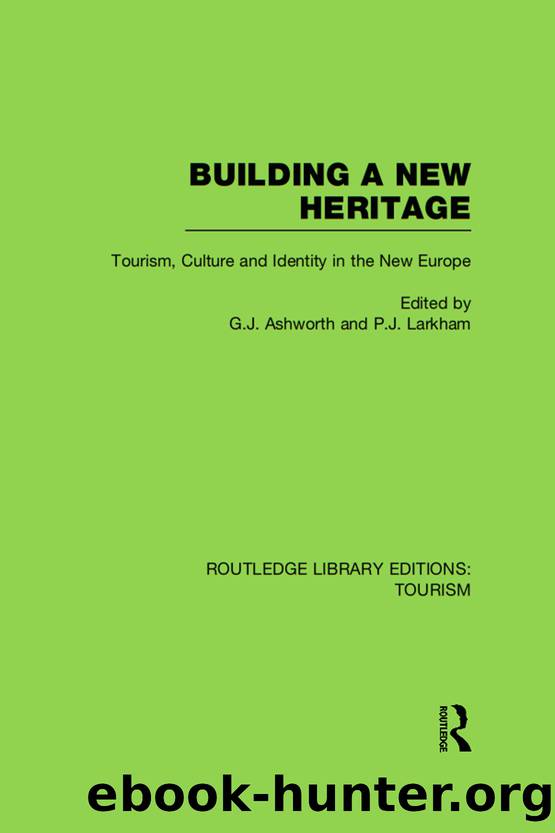Building a New Heritage (RLE Tourism) by Ashworth Gregory;Larkham Peter;

Author:Ashworth, Gregory;Larkham, Peter;
Language: eng
Format: epub
Publisher: Taylor & Francis Group
Figure 8.1 Lord Carson, Irish Unionist Party leader from 1910 to 1920, gesticulates defiantly southwards from his plinth in front of Stormont
Source: Photograph by the author
It is precisely this Unionist failure to recognize that a claim to territory is not in itself sufficient to create a feeling of belonging to the place claimed which is addressed in the second argument that Ulster is a separate cultural entity with its own distinct cultural and material heritage and communal sense of identity. This can be regarded as a conscious attempt to lay siege to that moral high ground. We can see the converse of the Unionist stance on heritage in the development of this perspective, the essentials of which rest upon the creation of an Ulster origin-myth which establishes both a separate identity and legitimation of the claim of Ulster Protestants to their territory within the island of Ireland. In the most developed justification of this viewpoint, Adamson (1991: 104) argues that Ulster's historical and cultural heritage contains within it âthe proof of the common identity of northernersâ. Somewhat ironically, he uses precisely the same sort of heritage sources and artefacts as did traditional Gaelic nationalism. Thus, his arguments are also characterized by time-collapse, the origins of Ulster identity resting in a long-past age (Adamson 1978). In this origin-myth, the earliest inhabitants of what is now Ulster were the Cruthin, who controlled a Scots-Irish cultural province prior to the arrival in Ireland of the Celts (Gaels). In this interpretation, Cú Chulainn, the hero of the Ulster Cycle, the pseudo-histories of the province, the most famous of which is the Táin bó Cúailgne (The Cattle Raid of Cooley), is reincarnated as the leader of the Ulster resistance against the invading Gaels who eventually pushed the Cruthin back to the extreme north-east of the region. As Buckley (1991: 269) points out, there is a wonderful irony in this, as a statue of Cú Chulainn stands in Dublin's Central Post Office to commemorate the revolutionaries of the 1916 uprising, central figures in the pantheon of martyred heroes of the new Irish nation state. But even the Gaels of Ulster, it is argued, had more in common with those of Scotland than the remainder of Ireland. Thus the Plantations of the sixteenth and seventeenth centuries, the colonization of oppressors in the Gaelic myth, can be depicted as a reconquest by a Scots-Irish people who had once been expelled from their rightful territory by the invading Gaels. Adamson (1982: 108) sets out to âcreate a deeper sense of belonging to the country of our ancestors. For this Land of the Cruthin is our Homeland and we are her children.â Clearly, this is historiography to underpin an Ulster independence, which â as Aughey (1989: 14) observes â is tantamount to accepting the nationalist case that Ulster is not part of a United Kingdom.
Third, there is the argument which rejects this notion of communal Ulster separateness, in turn seeking to define a nine-county Ulster as but one region in a diversified pluralistic Ireland.
Download
This site does not store any files on its server. We only index and link to content provided by other sites. Please contact the content providers to delete copyright contents if any and email us, we'll remove relevant links or contents immediately.
Life 3.0: Being Human in the Age of Artificial Intelligence by Tegmark Max(5475)
The Sports Rules Book by Human Kinetics(4296)
The Age of Surveillance Capitalism by Shoshana Zuboff(4213)
ACT Math For Dummies by Zegarelli Mark(3996)
Unlabel: Selling You Without Selling Out by Marc Ecko(3591)
Blood, Sweat, and Pixels by Jason Schreier(3566)
Hidden Persuasion: 33 psychological influence techniques in advertising by Marc Andrews & Matthijs van Leeuwen & Rick van Baaren(3474)
The Pixar Touch by David A. Price(3364)
Bad Pharma by Ben Goldacre(3357)
Urban Outlaw by Magnus Walker(3342)
Project Animal Farm: An Accidental Journey into the Secret World of Farming and the Truth About Our Food by Sonia Faruqi(3178)
Kitchen confidential by Anthony Bourdain(3010)
Brotopia by Emily Chang(3001)
Slugfest by Reed Tucker(2942)
The Content Trap by Bharat Anand(2863)
The Airbnb Story by Leigh Gallagher(2800)
Coffee for One by KJ Fallon(2567)
Smuggler's Cove: Exotic Cocktails, Rum, and the Cult of Tiki by Martin Cate & Rebecca Cate(2473)
Beer is proof God loves us by Charles W. Bamforth(2374)
